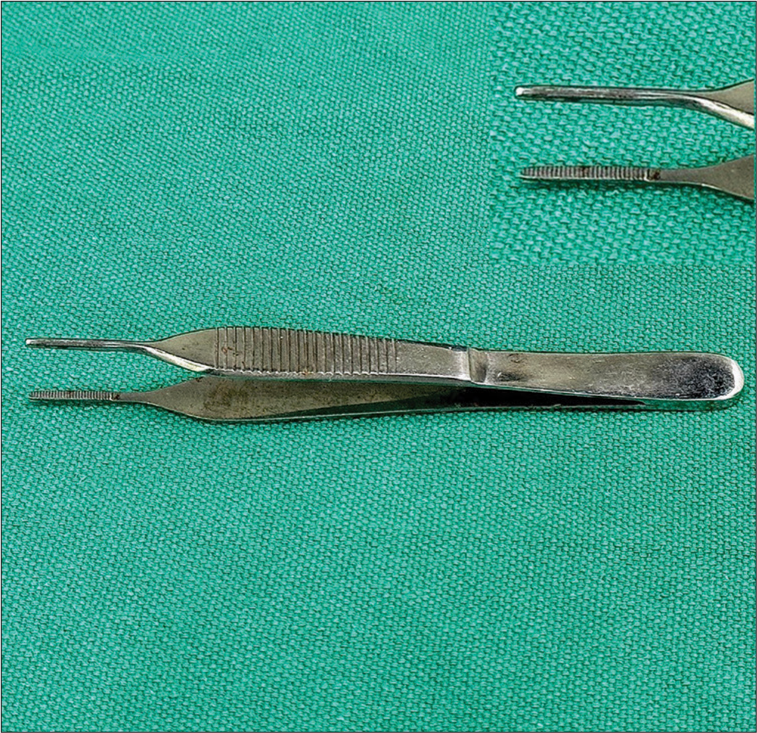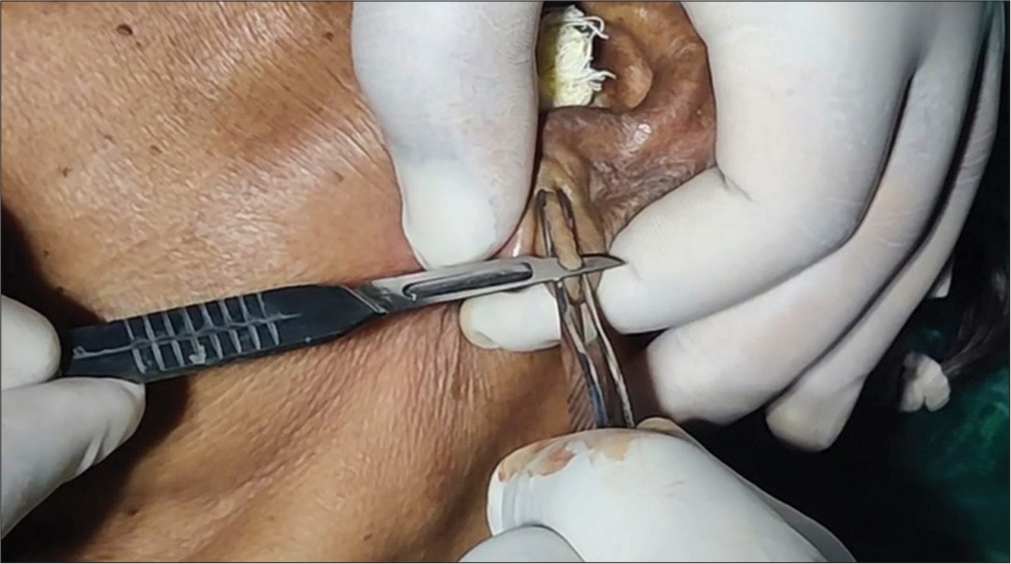Translate this page into:
Enhancing precision in a complete earlobe tear repair with Adson’s forceps

*Corresponding author: Akshay Arun Vetal, Department of Dermatology, Lokmanya Tilak Municipal Medical College and General Hospital, Mumbai, Maharashtra, India. akkiii5858@gmail.com
-
Received: ,
Accepted: ,
How to cite this article: Vetal AA, Dhurat RS, Maity A, Srivatsa KR. Enhancing precision in a complete earlobe tear repair with Adson’s forceps. CosmoDerma. 2024;4:108. doi: 10.25259/CSDM_122_2024
PROBLEM
The earlobe is one of the most fleshy and mobile areas on the body, making it difficult to keep steady during cosmetic repair. The lobuloplasty of a complete ear lobe tear (Type III) requires precision to avoid excessive tissue removal and maintain the natural contour of the earlobe.[1,2] Maintaining linear cuts is challenging, especially with the earlobe’s tendency to slip during handling. Traditional methods often involve freshening the cleft margins by excising Cleft tissue with a scalpel.[3] However, incomplete excision or over-excision can result in grooving along the suture line, notching of the inferior margin and contour irregularities.[4] In addition, maintaining hemostasis can be tricky, as excessive use of tumescent fluid to firm the tissue is needed.
SOLUTION
Our innovative approach leverages the unique design of Adson dressing forceps to address these challenges effectively [Figure 1].

- The fine, serrated, and non-traumatic tips of the Adson dressing forceps provide precise gripping of tissue.
PROCEDURE
After sterilization of the earlobe area and administration of local anesthetic, Adson forceps are used to secure the earlobe tissue.
The cleft margins, lateral followed by medial or vice versa, are scored in a single sweeping motion using the forceps [Figure 2].
Once the margins are freshened and hemostasis is achieved, suturing is performed using intermittent vertical mattress sutures with polypropylene for better approximation.

- The cleft margin is held with the forceps and is scored in a single sweeping motion.
ADVANTAGES OF ADSON DRESSING FORCEPS
The fine, serrated, non-traumatic tips of the Adson dressing forceps provide precise gripping of the earlobe tissue, preventing slippage, and enabling adequate excision. This prevents contour irregularities and notching of the inferior margin [Video 1].
The ergonomic design ensures that the cuts remain straight and clean, pivotal for achieving a neat margin and esthetically precise repair.
The gentle pressure applied with the tips of the Adson forceps aids in hemostasis without the need for excessive use of epinephrine or local tumescence.
Using a greater auricular nerve block with plain lignocaine minimizes tissue distortion due to excessive local fluid volume injection.
By emphasizing the use of Adson dressing forceps, this method ensures a more controlled and precise lobuloplasty procedure, improving esthetic outcomes and reducing the risk of complications.
Ethical approval
The Institutional Review Board approval is not required.
Declaration of patient consent
The authors certify that they have obtained all appropriate patient consent.
Conflicts of interest
There are no conflicts of interest.
Use of artificial intelligence (AI)-assisted technology for manuscript preparation
The authors confirm that there was no use of artificial intelligence (AI)-assisted technology for assisting in the writing or editing of the manuscript and no images were manipulated using AI.
Video 1 available on:
Financial support and sponsorship
Nil.
References
- A revised classification and treatment algorithm for acquired split Earlobe, with a description of the composite technique and its outcome. Cureus. 2020;12:e10422.
- [CrossRef] [PubMed] [Google Scholar]
- The cleft earlobe: A review of methods of treatment. Ann Plast Surg. 1994;33:677-680. 10.1097/00000637-199412000-00023
- [CrossRef] [PubMed] [Google Scholar]
- Pardue AM: Repair of torn earlobe with preservation of the perforation for an earring. Plast Reconstr Surg. 1973;51:472-3.
- [CrossRef] [PubMed] [Google Scholar]
- Eleven pearls for cosmetic earlobe repair. Dermatol Surg. 2002;28:180-5.
- [CrossRef] [Google Scholar]





